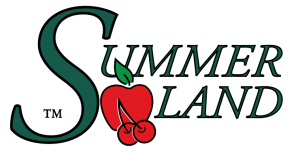Virus and Virus-like Diseases
General Description
There are many different virus diseases of stone and pome fruits. They can affect size, shape and quality of fruit, and can induce colour patterns and distortions on leaves. Viruses can also cause dieback, bark symptoms, gumming, stock-scion incompatibilities and tree death. Some viruses produce distinctive symptoms, while others are much harder to detect visually.
What is a virus?
Virus diseases are caused by microscopic particles that are composed of genetic material (DNA or RNA) inside a protective protein coat. Viruses are much smaller than bacteria and fungi, and require very specialized tests for their detection. Once inside a living plant, viruses have the ability to multiply by taking over plant cells and reprogramming them to make more virus particles. In tree fruit, the virus will spread systemically to all parts of the tree including the roots. Once a tree is infected, it will remain so for life.
General Virus Symptoms
Tree fruit viruses cause a wide range of symptoms, ranging from no visible symptoms to plant death. Many viruses cause a general decline in vigour and productivity. Some cause tree dieback that can be mistaken for other diseases such as bacterial canker. Foliar symptoms may include leaf distortion or twisting, leaf mottle, leaf roll, necrotic spots, shothole, and unusual colour patterns. Fruit symptoms may include reductions in size and quality, distortions in shape, and markings such as ringspots, pits, mottling or line patterns.
.jpg) |
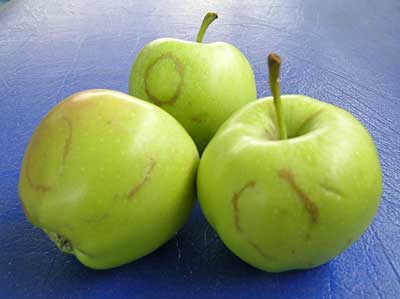 |
| Apple green crinkle associated virus causes fruit distortion in 'Aurora Golden Gala' apple (BCMA). |
Ring russet of apple is associated with Apple chlorotic leaf spot virus (BCMA) |
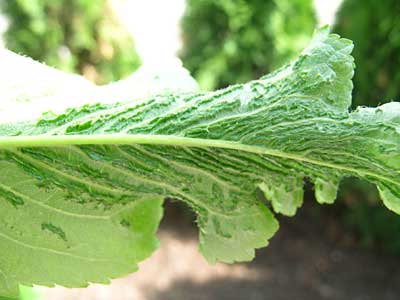 |
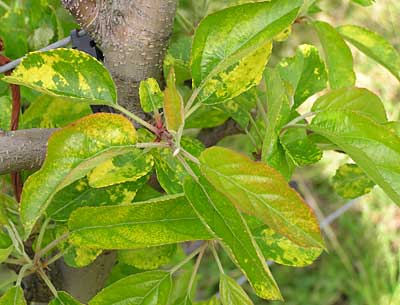 |
| Cherry rasp leaf virus symptoms on cherry leaf (BCMA). | Apple mosaic virus leaf symptoms (BCMA) |
It is possible for a virus to infect a tree without causing any obvious symptoms (called a latent virus or sleeping virus). The degree of virus symptom development and effect on a plant is influenced by the virus strain, plant variety, and environment. A previously latent virus may become more virulent (or more severe) at some time due to changes in the environment or through propagation, often onto a different rootstock. Cool springs often "bring out" virus symptoms.
How Viruses are Spread
Tree fruit viruses are spread primarily by infected propagative material, including rootstocks, budwood or scionwood and finished plants. Most viruses also have other methods of short-distance spread, although not all are known. Insects or other organisms that spread viruses are known as vectors. Examples of virus vectors include aphids, leafhoppers, psyllids, mealybugs, mites, and some species of nematodes. Many tree fruit viruses can spread through natural root grafting to neighbouring trees. Some tree fruit viruses can be spread in pollen.
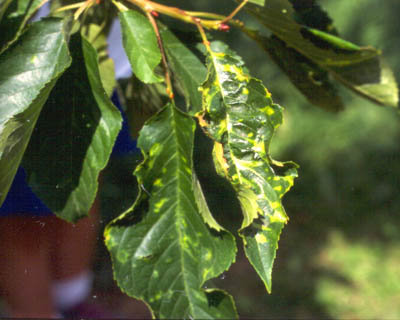 |
.jpg) |
| Cherry mottle leaf virus symptoms on cherry leaves | Pear stony pit is associated with Apple stem pitting virus. (BCMA) |
Management
Biological Control
Some viruses are spread by insects. Often these insect vectors have natural enemies such as native predatory and parasitic insects. Preserve populations of beneficial insects by careful selection and timing of insecticides.
Cultural Control
-
Plant only nursery stock certified as virus-free from a reliable source
-
When propagating their own trees, growers should be sure that both rootstock and scion are free from damaging viruses.
-
If an insect vector is known to spread a virus, controlling the insect may help to limit or reduce the rate of spread within an orchard.
-
Remove trees showing virus symptoms to protect other trees in the planting from becoming infected.
-
Contact your crop management advisor for further information.
Chemical Control
There are no chemical treatments available that will cure virus-infected plants.
Updated January, 2017
